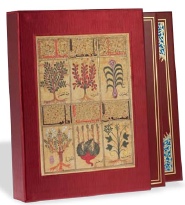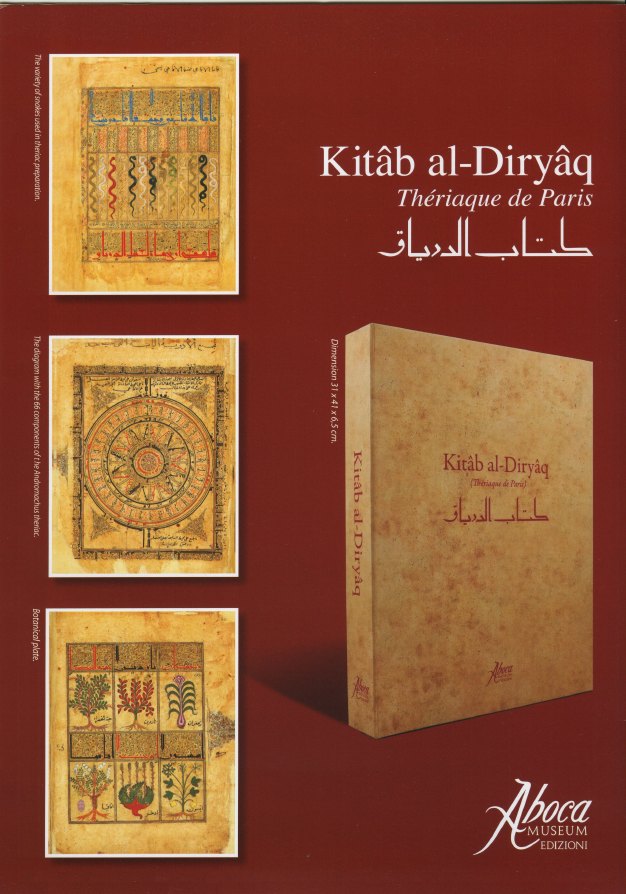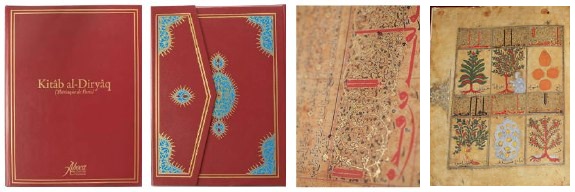|
| Kitâb al-Diryâq Thériaque de Paris Muhammad ibn Abi al-Fath |
 |
|
|
| An
extraordinary Arab manuscript from 1198 with gilded illuminations of medicinal plants used for recipes drawn up by the most important physicians in the Greek tradition | Paris, Bibl. Nat., ms. arabe 2964 deluxe facsimile edition Introduction by Oleg Grabar, Francoise Micheau, Jaclynne Kerner, Anna Caiozzo, Marie Genèvieve Guesdon |
|
|
|  |
| | This fascinating Arab manuscript describes theriac, the ancient medicinal compound that was initially used as a specific cure for bites given by poisonous snakes and wild animals (in ancient Greek, thèrion) and which later became widely used as a panacea. The extraordinary illuminated and gilded illustrations transform each of the 72 pages into a valuable work of art redolent of the fascination of the Oriental world. The work of Muhammad ibn Abi al-Fath and dated 1198, the manuscript is of special interest to scholars of botany and the history of medicine. It includes illustrations of the medicinal plants used in the Arab world in the recipes drawn up by the most important physicians in the Greek tradition, such as Galen of Pergamum and Andromachus. The number of ingredients used to create the medicine increased progressively with the passing of the centuries until it exceeded one hundred. Theriac originated in Graeco-Roman antiquity and its popularity was furthered in the Islamic world, giving rise to a vast literature on the subject. This particular manuscript is the earliest and most impressive of these treatises, and was probably produced for a very special patron of the arts who wished to know more of the medicine, but also to gaze on the beautiful colored illustrations. Conserved in the Bibliothèque Nationale in Paris (arabe 2964), this treatise is called the Paris Kitâb al- Diryâq to distinguish it from other copies in Beirut, Cairo, St Petersburg and Vienna. These latter codices are similar but were compiled at a later date. The growing popularity of theriac in Europe was partly due to the influence exercised by Latin translations of Arab treatises and to the development of trade in the Mediterranean: rare and unknown ingredients such as aromatizing “spices” and medicinal drugs were included in the composition of the preparation in the medical centres of Venice, Paris, Montpellier and others. But the Kitâb al-Diryâq is not only a medical treatise: it is also an engaging series of tales and anecdotes about the nine Greek physicians of antiquity who contributed to the development of the medicine. | The work
that has been handed down to us, written in ancient Arabic and with
notes in Persian, consists of 36 sheets (72 pages) embellished with
magnificent miniatures featuring traditional Arabizing motifs that only
in a few cases have lost their details and brightness of color. The
introductory pages (1-5), which feature decorations and
drawings, are devoted to the general contents and precede the two
amazing pages of the frontispiece (6-7) dedicated to the moon and its
astrological and magical myths. The calligraphic pages that follow
(from 8 to 49) are individual works of art in which the Kufic script is
also used as a decorative feature.
Following the title of the work, which is repeated several times, are
the portraits of the nine medical scholars (Andromachus the Elder,
Heraclides, Philagrius, Proclus, Pythagoras, Marinus, Magnus of Mesa,
Andromachus the Younger and Galen), each with his own theriac recipe,
and four anecdotes relating to Andromachus the Elder, Heraclides,
Philagrius and Proclus. The long presentation of the categories of
poisonous snakes and “viper esh” is linked to Andromachus the Younger.
Then follow twelve pages (50 to 61) with the illustration of the plants
used in the preparation of theriac: these include rocket, liquorice,
cardamom, opium, white pepper, incense, capers, acacia, valerian, black
pepper, garlic and wild leek.
The final pages (62 to 73) contain a group of eleven medicinal
recipes based on poorly identified cooked meat. The facsimile: Full color reproduction in the original format (28.5 x 37 cm), 72 pp bound in goatskin. Scholarly commentary in French/English (272 pp) by Oleg Grabar, Francoise Micheau, Jaclynne Kerner, Anna Caiozzo, & Marie Genèvieve Guesdon. Published by the Aboca Museum, Sansepolcro, 2009. Limited edition of 999 copies. Eu 2,980. (Please call for special OMI price) | |
 |
OMI - Old Manuscripts & Incunabula PO Box 6019 FDR Station, New York NY 10150
tel/fax 212/ 758-1946 - http://www.omifacsimiles.com - immels@earthlink.net